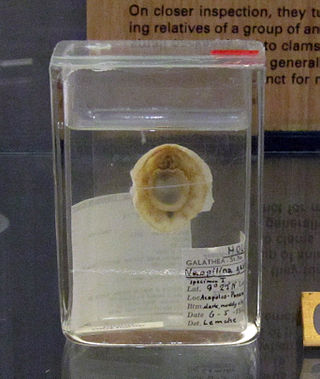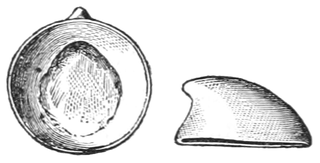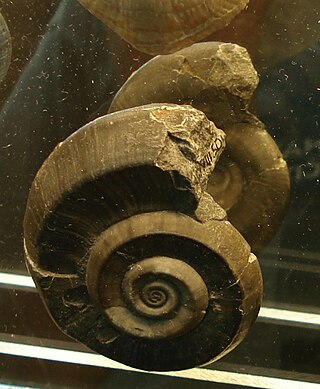
Monoplacophora, meaning "bearing one plate", is a polyphyletic superclass of molluscs with a cap-like shell, inhabiting deep sea environments. Extant representatives were not recognized as such until 1952; previously they were known only from the fossil record, and were thought to have become extinct 375 million years ago.
Strepsodiscus is an extinct genus of very primitive fossil snail-like molluscs from the early part of the Late Cambrian of North America. The coiled, slightly asymmetrical shells are about 3 cm in height. It is not known whether these are shells of gastropods or monoplacophorans, which are more primitive mollusks.

The Bellerophontidae are an extinct family of specialized globose bellerophontids, Paleozoic and early Triassic mollusks of the class Gastropoda.

Turbonillinae is a subfamily of mostly minute parasitic sea snails, marine gastropod molluscs in the family Pyramidellidae, the pyrams and their allies.

Latouchella is an extinct genus of marine invertebrate animal, that is considered to be a mollusk and which may be a sea snail, a gastropod. It is a helcionellid from the Tommotian epoch of what is now Siberia. Its tightly coiled, spiral shell contains a number of low "walls" running up the front surface of the interior; these would have directed water currents within its shell. Between these walls are a series of furrows, parallel to the shell's aperture, giving casts of the internal structure the appearance of a railway line, with sleepers tying together paired rails that run towards the apex of the shell.

Helcionelloida is an extinct group of ancient molluscs. These are the oldest known conchiferan molluscs, that is, they had a mineralised shell. Some members of this class were mistaken for Monoplacophorans. The class was erected by Peel in 1991.

Bellerophontoidea, common name "bellerophonts", is a superfamily of extinct planospirally-coiled globose molluscs. This superfamily is generally included within the Gastropoda, but may instead be a group of monoplacophorans. The taxon first appeared late in the Cambrian and continued until late in the Triassic.

†Archinacellidae is an extinct family of paleozoic molluscs of uncertain position.
Bucanellidae is an extinct family of Paleozoic molluscs of uncertain position, belonging either to Gastropoda (snails) or Monoplacophora. The family lived from the upper Cambrian to middle Permian and the shells are characterized by a relatively small median sinus in the upper margin of the aperture, and collabral (transverse) or spiral (longitudinal) threads covering the shell. The shells are planispirally coiled rather than trochospirally with a spire as is the case with most shelled gastropods.

Tremanotidae is an extinct family of Paleozoic fossil molluscs with isostrophically coiled shells. They occupy an uncertain position taxonomically: it is not known whether they were (gastropods or monoplacophorans.
Bucaniidae is an extinct family of Paleozoic molluscs of uncertain position possibly being either gastropods or monoplacophorans in the superfamily Bellerophontoidea. The family lived from the Lower Ordovician to the Devonian and have shells in which the apertural margins tend to flare. Most genera have a slit and selenizone, others some modification of this feature.
Euphemitidae is an extinct family of Paleozoic fossil molluscs of uncertain position. They have isostrophically coiled shells and may be either Gastropoda sea (snail)s, or Monoplacophora.
Pterothecidae is an extinct family of Paleozoic molluscs of uncertain position, either Gastropoda or Monoplacophora, with isostrophically coiled shells.
Sinuitidae is an extinct family of Paleozoic molluscs of uncertain position. They had isostrophically coiled shells.
Omphalotrochidae is an extinct taxonomic family of Paleozoic molluscs (gastropods?) with anisostrophically coiled shells of uncertain position (Gastropoda?).
Omphalocirridae is an extinct family of Paleozoic molluscs (gastropods?) with anisostrophically coiled shells of uncertain position (Gastropoda?).
Helicotomidae is an extinct family of Paleozoic molluscs (gastropods?) with anisostrophically coiled shells of uncertain position (Gastropoda?).

Lesueurillidae is an extinct family of paleozoic molluscs (gastropods?) with anisostrophically coiled shells of uncertain position (Gastropoda?).
†Onychochilidae is an extinct family of small, fossil, upper Cambrian to lower Devonian molluscs. They have hyperstrophically coiled shells which generally have smooth whorls and elongate apertures. They are commonly considered to be gastropods, i.e. sea snails.

Euomphaloidea, originally Euomphalacea, is an extinct superfamily of marine molluscs that lived from the Early Ordovician to the Late Cretaceous, included in the Gastropoda but speculated as instead perhaps Monoplacophora.








